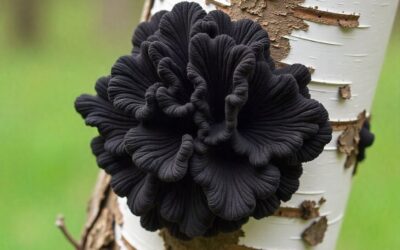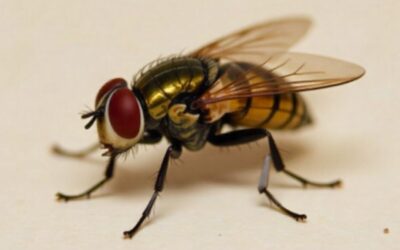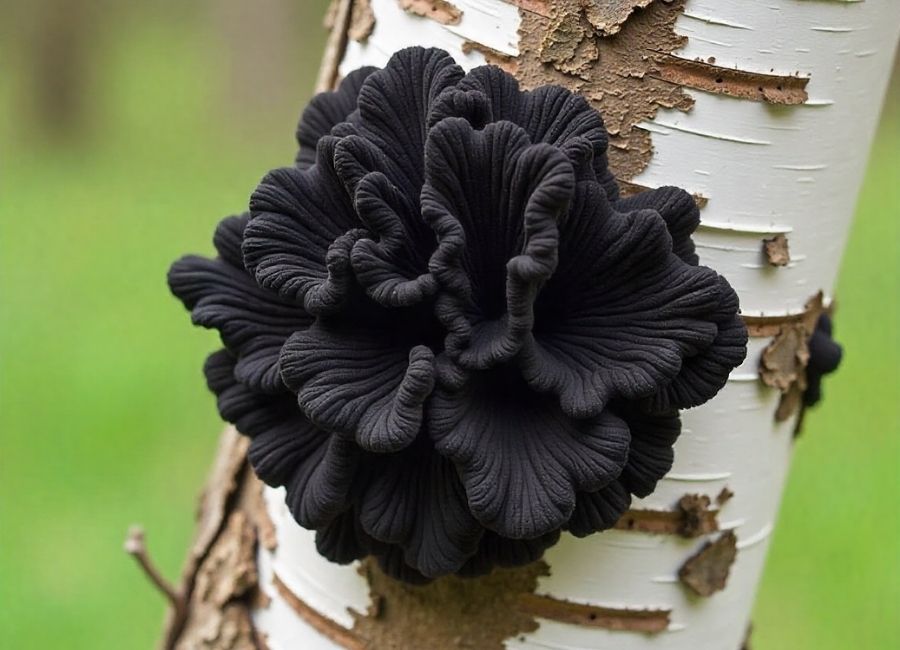Chaga mushrooms are now well-known as a superfood, but finding and harvesting them means you need to know what to look for. Instead of the usual mushroom shape, chaga grows as black, crusty patches on birch trees, which can make it tricky for beginners to identify.
This guide will help you learn how to spot chaga mushrooms in the wild, recognize their main features, and avoid confusing them with other fungi. Whether you love foraging or are just curious, you’ll pick up the key skills to find real chaga where it grows.
It’s important to identify chaga correctly, both for a good harvest and for your safety. Mistaking one fungus for another can be disappointing or even risky. By the end of this article, you’ll feel ready to find chaga mushrooms with confidence.
What Is Chaga Mushroom?
Chaga (Inonotus obliquus) is a fungus that mostly grows on birch trees in cold areas. (Hardwood Stem Decays, n.d.) Instead of the usual mushroom cap, chaga forms a hard, woody lump on the outside of the tree.
People have used chaga in traditional medicine for hundreds of years, especially in Russia, Korea, and other northern places. (History of chaga, n.d.) Its outside is black and looks like charcoal, while the inside is rust-colored and cork-like, packed with helpful compounds.
Chaga takes years, sometimes even decades, to grow into the dense, nutrient-rich clumps that people value. (4 Factors Influencing Chaga Growth, n.d.) It lives off the birch tree, slowly weakening it as it gathers nutrients and useful compounds inside itself.
Key Physical Characteristics of Chaga
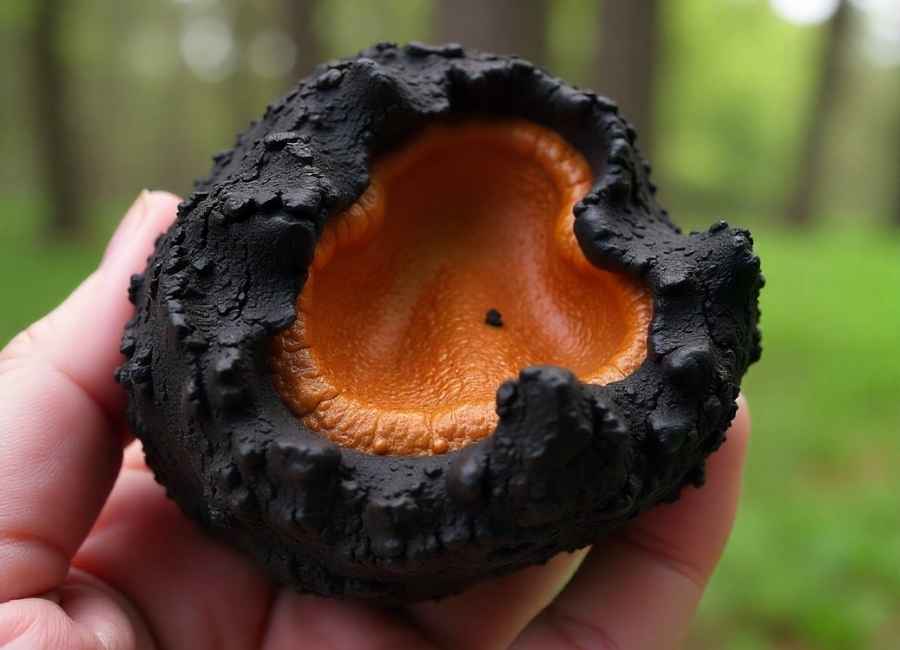
Exterior Appearance
Chaga stands out because of its black, crusty outside, which looks like burnt charcoal or a chunk of coal stuck to a tree. This rough, brittle layer often has cracks and feels almost like rock.
When chaga is fresh, its outside can be a bit softer, but it gets harder and more brittle as it ages. The black color comes from melanin, which also gives color to human skin. This tough shell helps chaga make it through cold winters.
Size can vary dramatically, from small growths the size of a golf ball to massive formations weighing several pounds. The shape is typically irregular and bulbous, following the contours of the tree bark where it emerges.
Interior Characteristics
If you break or cut open chaga, you’ll see a very different inside. It has a rust-orange to reddish-brown color and feels like cork. This part holds most of the helpful compounds found in chaga.
The texture feels somewhat soft and crumbly when fresWhen fresh, the inside feels a bit soft and crumbly, but it gets harder as it dries. The color and texture inside are even, without the wood grain you see in tree bark.cork-like appearance throughout. Any sections that look like wood grain, show green coloration, or appear overly moist may indicate contamination or misidentification.
Where to Find Chaga Mushrooms
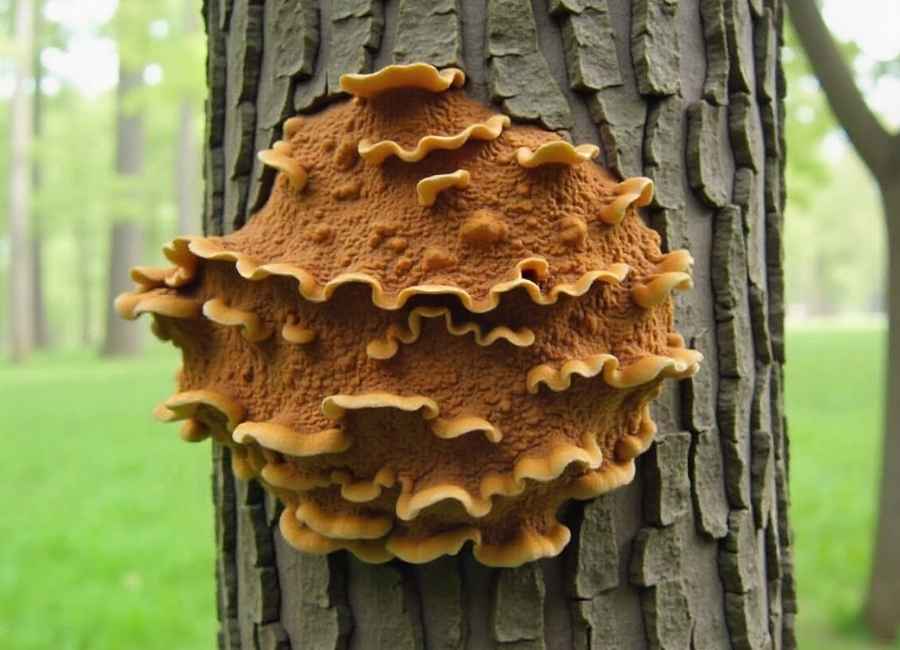
Preferred Host Trees
Chaga shows a strong preference for birch trees, particularly paper birch (Betula papyrifera) and other birch species. (Chaga Mushroom Identification (A Forager’s Guide), n.d.) While chaga can occasionally grow on other hardwood trees like beech or maple, birch trees provide the ideal environment and nutrients for optimal growth. (What Trees Does the Chaga Fungus Grow On?, n.d.)
Search for older birch trees with thick trunks, since chaga usually needs mature trees to grow well. You won’t often find good-sized chaga on young or small birches. Most chaga grows on trees that are at least 20 years old. (The Two Sides of Chaga: The Complete Guide to Sustainable Chaga Use, n.d.)
Chaga can grow on healthy birch trees, but it often appears on trees that are stressed or starting to decline. Because chaga is a parasite, trees with chaga may slowly get weaker over time. (Chaga – Mushroom Education, n.d.)
Geographic Distribution
Chaga thrives in cold, northern climates across North America, Northern Europe, and Asia. (Ultimate Guide To Chaga Mushrooms, n.d.) In North America, you’ll find chaga primarily in Canada, Alaska, and the northern United States, including Maine, Vermont, New Hampshire, Minnesota, Wisconsin, and Michigan. (Ultimate Guide To Chaga Mushrooms, n.d.)
The fungus requires consistent cold temperatures during winter months to develop properly. (Where Does Chaga Grow? Locations and Growth Conditions, 2024) Regions with harsh winters and moderate summers provide ideal conditions for chaga growth and development. (Where Does Chaga Grow? Habitats, Host Trees & Environments, n.d.)
Climate change has begun affecting chaBecause of climate change, chaga is becoming less common in warmer areas. (Chaga Mushroom Benefits, Habitat & Medicinal Preparations, n.d.) For the best chance of finding it, search in cold regions with lots of birch trees.and early spring offer the best visibility for chaga identification. Without leaves on deciduous trees, the black growths stand out clearly against light-colored birch bark and snowy backgrounds.
Look for chaga during the day when you can see colors and textures clearly. The black chaga is easiest to spot against the white birch bark in good light.
Focus on mature birch stands rather than young forests. Older, established birch trees are more likely to host significant chaga growths worth harvesting.
Common Look-Alikes and How to Avoid Them
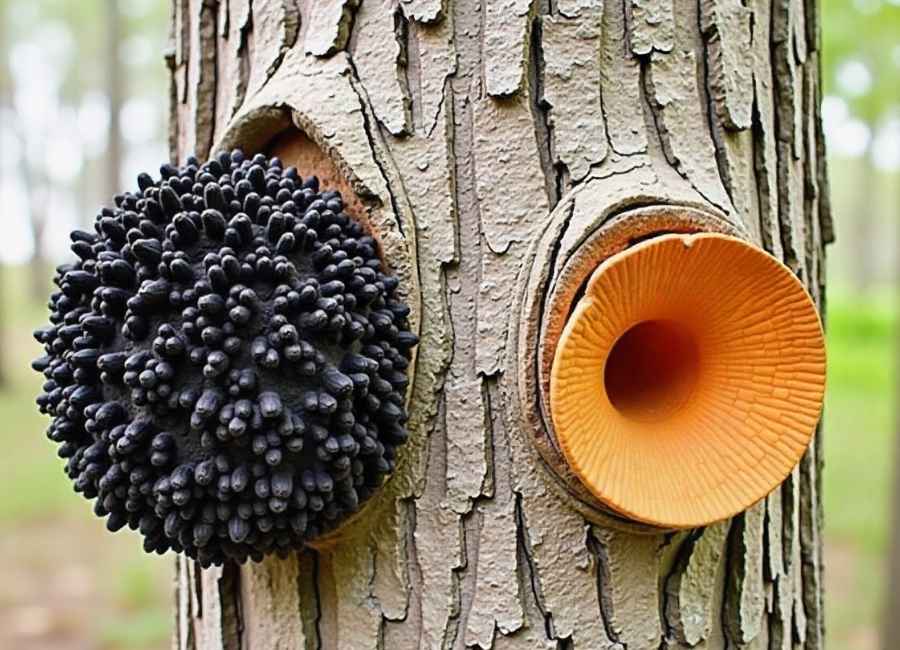
Burl Growths
Tree burls can sometimes be mistaken for chaga, especially by beginners. Burls are woody growths caused by stress or injury to the tree, appearing as large, rounded protrusions on the trunk. However, burls maintain the same coloration and texture as the host tree’s bark and wood.
Burls don’t have chaga’s black outside or orange inside. Instead, they show wood grain all the way through and match the tree’s natural color. Burls feel hard and woody, not brittle like chaga.
When cut open, burls reveal typical wood grain and coloration, completely different from chaga’s uniform cork-like interior. If you’re unsure, a small test cut will immediately reveal the difference.
Fungal Shelf Mushrooms
Some shelf fungi and bracket fungi also grow on trees and can confuse new foragers. These types usually look like shelves or brackets sticking out from the trunk, with visible pores underneath.
True shelf fungi have defined caps, stems, or bracket shapes, unlike chaga’s irregular, bulbous formation. Most shelf fungi also display lighter colors—browns, tans, or grays—rather than chaga’s distinctive black exterior.
The texture of shelf fungi feels more typically mushroom-like, often softer or more fibrous than chaga’s hard, brittle exterior. These fungi also lack chaga’s characteristic orange interior coloration.
Fire-Damaged Wood
Parts of trees that have been burned can look black and crusty, which might look like chaga from far away. But fire damage usually has burn marks or streaks that follow the wood grain.
Fire-damaged wood maintains woody characteristics underneath the charred exterior, lacking chaga’s unique cork-like interior. Burned wood also tends to be more brittle and crumbly than chaga’s relatively solid structure.
You can also use smell to tell them apart. Burned wood smells smoky, but fresh chaga has an earthy, mushroom scent.
Step-by-Step Identification Process
Initial Visual Assessment
Begin your identification from a distance, scanning birch trees for black, irregularly shaped growths. Look for formations that appear distinctly different from the smooth, white bark of healthy birch trees.
Approach promising specimens and examine the growth’s attachment to the tree. Chaga emerges directly from the trunk or major branches, appearing as if it’s growing out of the bark rather than simply attached to the surface.
Pay attention to the size and shape. Mature chaga is usually several inches wide, but even smaller pieces can be useful. Chaga should look three-dimensional and lumpy, not flat against the tree.
Physical Examination
When you find a possible chaga, touch it to check the texture. The outside should feel hard and brittle, like charcoal or burnt wood. Fresh chaga might be a bit softer, but older ones are very brittle.
Carefully scrape or break off a small piece from a hidden spot to look inside. Real chaga will show a rust-orange, cork-like inside right under the black surface.
Check for consistency throughout the specimen. The interior shoulCheck that the inside looks the same all the way through—orange and cork-like. If you see wood, green spots, or anything different, it might not be chaga.fication, consider these additional verification methods. The interior of fresh chaga should feel somewhat soft and crumbly, becoming harder as it dries.
True chaga has a distinctive earthy, slightly sweet aroma when fresh. Any strong, unpleasant odors may indicate decay or misidentification.
When in doubt, consult with experienced foragers or mycologists in your area. Many regions have foraging groups or experts who can help verify your identification and provide additional guidance.
Sustainable Harvesting Practices
Proper Harvesting Techniques
Never harvest all the chaga from a single tree. Take only what you need, leaving at least 20-30% of the growth to allow continued development and tree survival.
Use appropriate tools for harvesting, such as a sharp hatchet, saw, or sturdy knife. Clean cuts heal better than rough tears and reduce stress on both the fungus and host tree.
Take chaga from the outer parts of big clumps instead of cutting close to the trunk. This way, you protect the tree and let the fungus keep growing.
Environmental Considerations
Only harvest chaga from healthy, establishedOnly pick chaga from healthy, plentiful spots. Don’t take it from places where it’s rare or seems at risk.e harvesting. Trees already showing significant stress or decline should be left undisturbed to maintain ecosystem balance.
Change up where you harvest and don’t go back to the same trees too often. Wait a few years before picking from the same spot again to keep things sustainable.
Ready to Start Your Chaga Journey
Finding chaga mushrooms takes patience, practice, and a good eye. Once you know to look for the black outside, orange inside, and birch tree home, chaga becomes much easier to spot.
Remember that proper identification is only the first step. Sustainable harvesting practices ensure these valuable fungi remain available for future generations while maintaining healthy forest ecosystems.
Start your chaga journey by exploring birch forests in your region during optimal seasons. With the knowledge gained from this guide, you’re equipped to confidently identify authentic chaga mushrooms and distinguish them from potentially confusing look-alikes. Always prioritise safety and sustainability in your foraging adventures.










